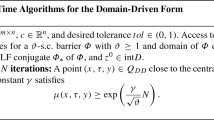Abstract
A novel approach for solving the DEA linear programming problems using a primaldual interior-point method is presented. The solution found by this method satisfies the Strong Complementarity Slackness Condition (SCSC) and maximizes the product of the positive components among all SCSC solutions. The first property is critical in the use of DEA and the second one contributes significantly to the reliability of the solution.
Similar content being viewed by others
References
Cooper, W.W., S. Kumbhakar, R.M. Thrall and X. Yu, DEA and stochastic frontier analyses of the 1978 Chinese economic reforms, Socio-Economic Planning Sciences 29, 1995, 85–112.
Charnes, A. and W.W. Cooper, Preface to topics in Data Envelopment Analysis, Annals of Operations Research 2, 1985, 59–94.
Charnes, A., W.W. Cooper and R.M. Thrall, Identifying and classifyign scale and technical efficiencies in Data Envelopment Analysis, Operations Research Letters 5, 1986, 105–116.
Charnes, A., W.W. Cooper and R.M. Thrall, A structure for classifying and characterizing efficiency and inefficiency in Data Envelopment Analysis, Journal of Productivity Analysis 2, 1991, 197–237.
El-Bakry, A., R.A. Tapia and Y. Zhang, On the use of indicators in identifying zero variables for interior-point methods, SIAM Review 36, 1994, 45–72.
Goldman, A.J. and A.W. Tucker, The theory of linear programming, inLinear Inequalities and Related Systems, H.W. Khun and A.W. Tucker, eds., Annals of Mathematics Studies No. 36, Princeton University Press, Princeton, NJ, 1956, pp. 53–97.
Gonzaga, C.C., Path-following methods for linear programming, SIAM Review 34, 1992, 167–224.
González-Lima, M.D., Effective computation of the analytic center of the solution set in linear programming using primal-dual interior-point methods, Technical Report TR94-48, Department of Mathematical Sciences, Rice University, 1994.
Kojima, M., S. Mizuno and A. Yoshise, A primal-dual interior-point method for linear programming, inProgress in Mathematical Programming, Interior-Point and Related Methods, N. Megiddo, ed., Springer, New York, 1989, pp. 29–47.
Lustig, I., R. Marsten and D. Shanno, On implementing Mehrota's predictor-corrector interior-point method for linear programming, SIAM Journal on Optimization 2, 1992, 435–449.
McLinden, L., An analogue of Moreau's approximation theorem, with application to the nonlinear complementarity problem, Pacific Journal of Mathematics 88, 1980, 101–161.
Megiddo, N., Pathways to the optimal set in linear programming, inProgress in Mathematical Programming, Interior-Point and Related Methods, N. Megiddo, ed., Springer, New York, 1989, pp. 131–158.
Rockafellar,Convex Analysis, 2nd printing, Princeton University Press, Princeton, NJ, 1972.
Sonnevend, G., An analytic center for polyhedrons and new classes of global algorithms for linear (smooth, convex) programming,Lecture Notes in Control and Inf. Sci., vol. 84, A. Prekopa, ed., Springer, Berlin, 1985, pp. 866–876.
Spivey, W.A. and R.M. Thrall,Linear Optimization, Holt, Rinehart and Winston, New York, 1970.
Thompson, R.G., P.S. Dharmapala, J. Diaz, M.D. González-Lima and R.M. Thrall, DEA multiplier analytic center sensitivity with an illustrative application to independent oil companies, Annals of Operations Research, Chapter 7, this volume.
Thompson, R.G., P.S. Dharmapala and R.M. Thrall, Sensitivity analysis of efficiency measures with applications to Kansas farming and Illinois coal mining, Chapter 20 inData Envelopment Analysis: Theory, Methodology and Applications, A. Charnes, W.W. Cooper, A.Y. Lewin and L.M. Seiford, eds., Kluwer, Boston, 1994, pp. 293–422.
Thompson, R.G., L. Langemeier, C.-T. Lee, E. Lee and R.M. Thrall, The role of multiplier bounds in efficiency analysis with application to Kansas farming, Journal of Econometrics 46, 1990, 93–108.
Thompson, R.G., P.S. Dharmapala, C.-T. Lee and R.M. Thrall, Fixed weights and DEA,Applications of Management Science, Vol. 7 of Public Policy Applications of Management Science, JAI Press, 1993, pp. 171–191.
Zhang, Y. and R.A. Tapia, On the convergence of interior-point methods to the center of the solution set in linear programming, Technical Report TR91-30, Department of Mathematical Science, Rice University, 1991.
Author information
Authors and Affiliations
Additional information
This research was partially supported by NSF Cooperative Agreement No. CCR-88-09615, ARO Grant 9DAAL03-90-G-0093, DOE Grant DEFG05-86-ER25017, and AFOSR Grant 89-0363.
Partially supported by Fulbright/LASPAU.
Rights and permissions
About this article
Cite this article
González-Lima, M.D., Tapia, R.A. & Thrall, R.M. Chapter 6 On the construction of strong complementarity slackness solutions for DEA linear programming problems using a primal-dual interior-point method. Ann Oper Res 66, 139–162 (1996). https://doi.org/10.1007/BF02187298
Issue Date:
DOI: https://doi.org/10.1007/BF02187298




